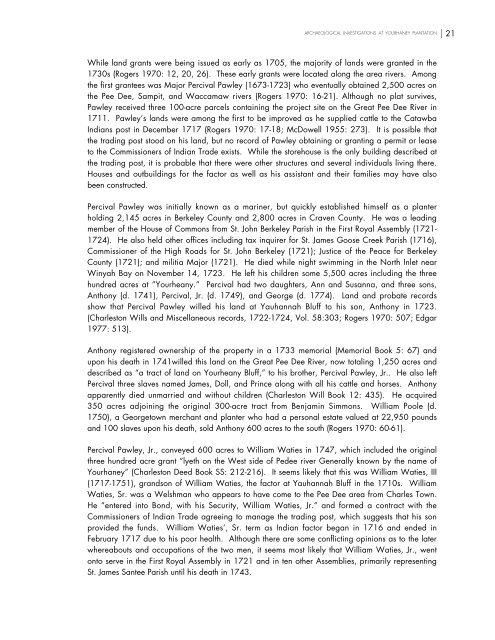Archaeological Investigations at Yourhaney Plantation (38GE18)
Archaeological Investigations at Yourhaney Plantation (38GE18)
Archaeological Investigations at Yourhaney Plantation (38GE18)
Create successful ePaper yourself
Turn your PDF publications into a flip-book with our unique Google optimized e-Paper software.
ARCHAEOLOGICAL INVESTIGATIONS AT YOURHANEY PLANTATION21While land grants were being issued as early as 1705, the majority of lands were granted in the1730s (Rogers 1970: 12, 20, 26). These early grants were loc<strong>at</strong>ed along the area rivers. Amongthe first grantees was Major Percival Pawley (1673-1723) who eventually obtained 2,500 acres onthe Pee Dee, Sampit, and Waccamaw rivers (Rogers 1970: 16-21). Although no pl<strong>at</strong> survives,Pawley received three 100-acre parcels containing the project site on the Gre<strong>at</strong> Pee Dee River in1711. Pawley’s lands were among the first to be improved as he supplied c<strong>at</strong>tle to the C<strong>at</strong>awbaIndians post in December 1717 (Rogers 1970: 17-18; McDowell 1955: 273). It is possible th<strong>at</strong>the trading post stood on his land, but no record of Pawley obtaining or granting a permit or leaseto the Commissioners of Indian Trade exists. While the storehouse is the only building described <strong>at</strong>the trading post, it is probable th<strong>at</strong> there were other structures and several individuals living there.Houses and outbuildings for the factor as well as his assistant and their families may have alsobeen constructed.Percival Pawley was initially known as a mariner, but quickly established himself as a planterholding 2,145 acres in Berkeley County and 2,800 acres in Craven County. He was a leadingmember of the House of Commons from St. John Berkeley Parish in the First Royal Assembly (1721-1724). He also held other offices including tax inquirer for St. James Goose Creek Parish (1716),Commissioner of the High Roads for St. John Berkeley (1721); Justice of the Peace for BerkeleyCounty (1721); and militia Major (1721). He died while night swimming in the North Inlet nearWinyah Bay on November 14, 1723. He left his children some 5,500 acres including the threehundred acres <strong>at</strong> “Yourheany.” Percival had two daughters, Ann and Susanna, and three sons,Anthony (d. 1741), Percival, Jr. (d. 1749), and George (d. 1774). Land and prob<strong>at</strong>e recordsshow th<strong>at</strong> Percival Pawley willed his land <strong>at</strong> Yauhannah Bluff to his son, Anthony in 1723.(Charleston Wills and Miscellaneous records, 1722-1724, Vol. 58:303; Rogers 1970: 507; Edgar1977: 513).Anthony registered ownership of the property in a 1733 memorial (Memorial Book 5: 67) andupon his de<strong>at</strong>h in 1741willed this land on the Gre<strong>at</strong> Pee Dee River, now totaling 1,250 acres anddescribed as “a tract of land on Yourheany Bluff,” to his brother, Percival Pawley, Jr.. He also leftPercival three slaves named James, Doll, and Prince along with all his c<strong>at</strong>tle and horses. Anthonyapparently died unmarried and without children (Charleston Will Book 12: 435). He acquired350 acres adjoining the original 300-acre tract from Benjamin Simmons. William Poole (d.1750), a Georgetown merchant and planter who had a personal est<strong>at</strong>e valued <strong>at</strong> 22,950 poundsand 100 slaves upon his de<strong>at</strong>h, sold Anthony 600 acres to the south (Rogers 1970: 60-61).Percival Pawley, Jr., conveyed 600 acres to William W<strong>at</strong>ies in 1747, which included the originalthree hundred acre grant “lyeth on the West side of Pedee river Generally known by the name of<strong>Yourhaney</strong>” (Charleston Deed Book SS: 212-216). It seems likely th<strong>at</strong> this was William W<strong>at</strong>ies, III(1717-1751), grandson of William W<strong>at</strong>ies, the factor <strong>at</strong> Yauhannah Bluff in the 1710s. WilliamW<strong>at</strong>ies, Sr. was a Welshman who appears to have come to the Pee Dee area from Charles Town.He “entered into Bond, with his Security, William W<strong>at</strong>ies, Jr.” and formed a contract with theCommissioners of Indian Trade agreeing to manage the trading post, which suggests th<strong>at</strong> his sonprovided the funds. William W<strong>at</strong>ies’, Sr. term as Indian factor began in 1716 and ended inFebruary 1717 due to his poor health. Although there are some conflicting opinions as to the l<strong>at</strong>erwhereabouts and occup<strong>at</strong>ions of the two men, it seems most likely th<strong>at</strong> William W<strong>at</strong>ies, Jr., wentonto serve in the First Royal Assembly in 1721 and in ten other Assemblies, primarily representingSt. James Santee Parish until his de<strong>at</strong>h in 1743.







